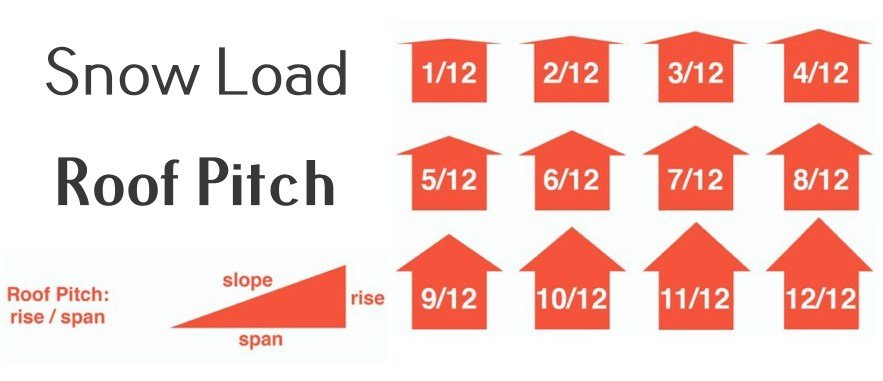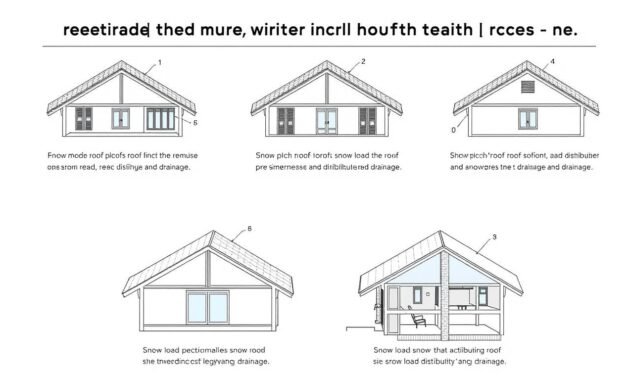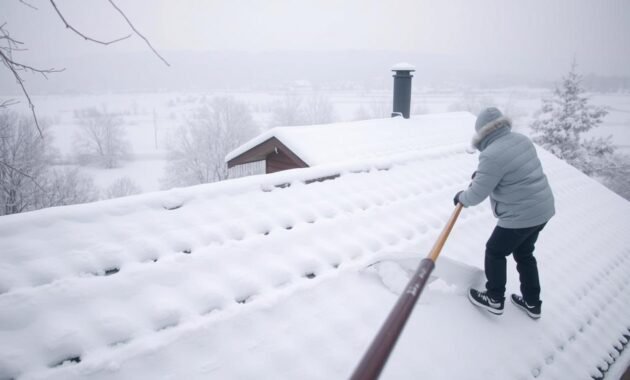Every winter, homeowners in snowy areas face a big challenge: keeping their roofs safe from snow damage. The wrong roof pitch can cause serious problems, like structural failures and expensive repairs. It can also lead to dangerous ice dams.
Understanding roof snow load is key to avoiding disaster. A well-designed roof can handle sliding snow and spread out the weight. This keeps your home safe and sound during the cold winter months.
This guide will help you learn how to protect your home from winter’s toughest conditions. You’ll discover how to calculate load distribution and choose the right materials. Stay ahead of winter’s challenges and save your roof and wallet.

Read also: How to Prevent Snow from Sliding Off Metal Roof
Understanding the Basics of Roof Pitch and Snow Load
Protecting your home in snowy areas means knowing about roof pitch and snow load. The design of your roof is key to handling snow and avoiding damage. Let’s explore the basics of roof slope and snow load every homeowner should grasp.
What Defines Roof Pitch
Roof pitch shows how steep a roof is. It’s measured as a ratio, like 4/12. This means the roof goes up 4 inches for every 12 inches across. Knowing this helps manage snow and keeps your roof strong.
- Flat roofs: 0-2 degree pitch
- Low-slope roofs: 2-10 degree pitch
- Moderate-slope roofs: 10-30 degree pitch
- Steep roofs: 30-45 degree pitch
Importance of Snow Load Calculations
Calculating snow load is vital for your roof’s winter strength. Each area has its own snow load needs. Always check local building codes and talk to a roofing expert to find out what your home needs.
Regional Weather Considerations
The weather in your area affects your roof’s design. Places with lots of snow need roofs that slope enough to shed snow. Steeper roofs help snow slide off, avoiding damage.
Knowing these basics helps homeowners make smart choices about their roof in snowy areas.
Snow Load Roof Pitch: Essential Guidelines for Homeowners
Protecting your home from winter’s challenges starts with knowing about roof pitch angles. Different places have different snow loads. This affects your roof’s load capacity and its strength.
Homeowners should watch their local weather when thinking about roof design. The right roof pitch helps prevent snow buildup and damage.
- For moderate snow areas: Minimum 4/12 pitch (approximately 30 degrees)
- For heavy snowfall regions: Recommended 6/12 pitch or higher
- Ideal pitch for optimal snow shedding: Between 30-45 degrees
Read also: How to Determine the Ideal Pitch for Shed Roof
Things that affect your roof’s load capacity include:
- Local snow density
- Roof material
- Structural support systems
- Wind patterns in your specific area
Getting a professional roof check can tell you if your roof meets snow load needs. Some might need to add roof support or change the pitch for winter safety.
Don’t wait for winter to check your roof. Planning ahead can avoid expensive fixes and risks from too much snow.
Calculating Snow Weight Impact on Different Roof Slopes
It’s important to know how snow load affects your roof’s safety. The slope of your roof greatly influences how snow piles up and spreads out.
There are key factors that affect how snow falls on your roof. The weight of snow changes a lot, depending on its density and your roof’s slope.
Snow Density Measurements
Snow density can vary a lot, based on where it falls. Here are the main things that affect snow weight:
- Freshly fallen snow: Typically lighter, around 5-10 pounds per cubic foot
- Packed snow: Can weigh 20-30 pounds per cubic foot
- Wet, compacted snow: May reach up to 50 pounds per cubic foot
Load Distribution Patterns
Roof slopes affect how snow spreads out. Steeper roofs tend to shed snow, while flatter ones keep more snow, putting more stress on the roof.
Mathematical Formulas for Load Assessment
Roof engineers use special math to figure out snow load risks. They multiply snow depth by its density and consider the roof’s slope.
Knowing these math tricks helps homeowners take better care of their roofs in snowy areas.
Recommended Minimum Pitch for Snowy Regions

In snowy areas, the right roof pitch is key for safety and strength. I’ve learned that the minimum pitch is vital for handling snow and avoiding roof damage.
Read also: Minimum Pitch for Shingles and Asphalt Shingles
Roof pitches range from 4/12 to 12/12, with steeper ones shedding snow better. For heavy snow, building codes suggest a 6/12 minimum pitch. This angle stops too much snow from building up and eases roof stress.
- 4/12 pitch: Minimal snow shedding, higher risk of accumulation
- 6/12 pitch: Recommended for snow-heavy regions
- 8/12 pitch: Excellent snow and water runoff
- 12/12 pitch: Maximum snow shedding
Your roof pitch should match your local climate and snow load standards. Talking to a professional roofer can help find the best pitch for your area and building.
Remember, roof pitch is just part of managing snow loads. Good insulation, ventilation, and upkeep are also key to protect your home from winter.
Best Roofing Materials for Snow-Heavy Areas
Choosing the right roofing material is key for snow-prone areas. Not all materials handle snow well. Knowing how much weight a roof can hold is important for keeping homes safe in winter.
There are several roofing materials that work well in snowy places. Let’s look at the best options for homeowners in these areas.
Metal Roofing Solutions
Metal roofs are great for snowy areas. Their smooth surface helps snow slide off easily. This reduces the risk of damage to the roof.
- Lightweight and durable design
- Low snow retention
- High resistance to moisture
- Long-lasting performance
Traditional Shingle Performance
Asphalt shingles are popular but face challenges in snowy areas. Their texture can hold snow, which can be a problem.
| Shingle Type | Snow Performance | Durability Rating |
|---|---|---|
| Architectural Shingles | Moderate | High |
| Three-Tab Shingles | Low | Medium |
Modern Synthetic Options
Synthetic roofing, like CeDUR shakes, offers new solutions for snow. These materials are durable and shed snow well. They provide extra protection against winter weather.
- Superior moisture resistance
- Lightweight construction
- Enhanced structural integrity
- Minimal maintenance requirements
Preventing Snow Accumulation and Ice Dam Formation
Roof snow can be a big problem for homeowners in cold areas. It’s important to know how to handle roof snow to keep your home safe and avoid damage.
To stop sliding snow and ice dams, you need a good plan. Here are some steps to help keep your roof safe during winter:
- Improve attic insulation to keep the roof temperature steady
- Make sure your roof has good ventilation to avoid heat buildup
- Put heat cables in spots where ice dams often form
- Clear snow off your roof regularly with roof rakes or get help from pros
Managing roof snow starts with knowing your home’s weak spots. Different roofs handle snow in different ways. So, it’s key to make a plan that fits your home’s needs.
| Prevention Method | Effectiveness | Cost Estimate |
|---|---|---|
| Enhanced Attic Insulation | High | $500 – $1,500 |
| Heat Cable Installation | Medium | $200 – $500 |
| Professional Snow Removal | High | $100 – $300 per service |
Spotting ice dam risks early can save you a lot of money. Look out for signs like icicles, uneven snow, and water stains inside. These can mean you have roof snow problems.
Structural Considerations for Snow Load Management
Keeping your home safe from heavy snowfall is key. Knowing how much weight your roof can handle is very important. I’ll share important tips to keep your roof strong and safe during winter.
Designing a roof for heavy snow involves many factors. Architects and builders must look at each element carefully. This ensures the roof can handle the snow load well.
Support System Requirements
A good roof support system is vital. It needs strong structural parts to spread out the weight. Important parts include:
- Robust truss design
- Reinforced connection points
- High-quality lumber or steel framing
- Proper spacing between structural supports
Load-Bearing Capacity Factors
To figure out a roof’s weight limit, we look at several things. Key factors to consider are:
- Roof pitch and angle
- Material strength
- Age of existing structure
- Local climate conditions
Building Code Compliance
Following local building codes is a must for roof safety. These rules set the minimum standards for roof building. They help ensure homes can handle expected snow loads in certain areas.
Professional engineers do detailed calculations to check snow weight impacts. This helps homeowners know their roof’s real weight limit. By following these tips, you can keep your home safe from winter damage.
Read also: How to Put a Ladder on a Sloped Roof Safely?
Maintenance Tips for Winter Roof Protection

Winter can be tough on your roof, and keeping it in good shape is key. I’ll share some important tips to help protect your roof during the cold months.
Regular checks are vital to avoid winter roof damage. I suggest inspecting your roof before and after big snowstorms. This helps spot problems early. Look for uneven snow or ice dams.
- Inspect roof edges and gutters for ice buildup
- Check for any sagging or stressed areas
- Remove sliding snow carefully to prevent structural damage
- Clean gutters and downspouts before winter
To stop sliding snow, use snow guards or heat cables. These tools help manage snow and prevent damage. They keep people and property safe.
Insulating your attic is also important. It stops heat from escaping, which can cause snow to melt unevenly. This can lead to ice dams. Make sure your attic is well-ventilated to keep the roof temperature steady.
- Add extra insulation to reduce heat loss
- Seal any air leaks in the attic
- Maintain proper attic ventilation
If you’re not sure about roof maintenance, consider hiring a pro. They can safely remove snow and check for damage. They’ll also give you advice on keeping your roof safe during winter.
Professional Assessment and Safety Guidelines
Winter weather can be tough on your home. It’s important to check your roof’s slope and how much snow it can handle. I’ve seen how DIY efforts can be risky when dealing with snow on roofs.
When should you call a professional? Look for these warning signs:
- Visible roof sagging or unusual structural deformation
- Large accumulations of snow and ice
- Cracking sounds or unusual structural noises
- Ice dam formation along roof edges
Roof inspectors have special tools to check how much snow your roof can take. They look at things like:
- Roof pitch and slope angles
- Building material strength
- Local climate conditions
- Structural support system integrity
It’s a good idea to get a professional roof check before winter starts. Experts can spot problems and save you from expensive repairs. They’ll tell you how much snow your roof can handle and give tips to keep it safe.
Your safety is key. Don’t try to remove snow without the right gear and skills. Professionals have the tools and know-how to do it safely, keeping your home strong.
Conclusion
Knowing about snow load roof pitch is key for homeowners in cold areas. My research shows how important roof design is for winter safety. The right roof pitch can protect your home from snow damage.
Managing roof snow load is more than just avoiding damage. It’s about keeping your home safe for years. I’ve found that good roof design, upkeep, and expert checks are vital for winter. Homeowners who learn about their roof’s limits can lower snow and ice risks.
If you live in a snowy area, be proactive about home safety. Talk to local roofers who know the weather and can guide you on roof pitch. These steps will keep your home safe, save on repairs, and make winters better.
Your roof is not just a part of your house. It’s your home’s shield against winter. Spending on the right design and care is a smart move. It keeps your property strong and your family safe.




